Synthés dans la variété internationale dans les années 70 et 80.
- 6 568 réponses
- 109 participants
- 341 020 vues
- 162 followers
vilak
3971
Squatteur·euse d’AF
Membre depuis 7 ans
Sujet de la discussion Posté le 26/03/2018 à 18:01:09Synthés dans la variété internationale dans les années 70 et 80.
Je fais un honteux copié-collé du post de Renaudg :
Alors on commence par celui-là.
Pro-one pour la basse et le synthé.
Pour le rythme j'entends divers sources : TR-808 + ARP 2600 ou TR-808 + Pro-one
Citation de renaudg :
Salut,
Je me suis souvent demandé quels étaient les synthés de prédilection sur un certain nombre de tubes 80s en variété/synthpop internationale qui ont quelques riffs mémorables.
Toutes infos bienvenues
Alors on commence par celui-là.
Pro-one pour la basse et le synthé.
Pour le rythme j'entends divers sources : TR-808 + ARP 2600 ou TR-808 + Pro-one
vilak
3971
Squatteur·euse d’AF
Membre depuis 7 ans
3781 Posté le 25/04/2022 à 22:35:20
Merci!!!
Le matos :
(Je reposte le contenu si je mets le lien vous irez pas voir, je vous connais maintenant!)
Kraftwerk, "Computer World Tour", 14 mai - 13 décembre 1981

A
First, there are two analogue sequencers which will produce up to 64 notes. The many rows of switches have 'in, shift and stop' settings for trigger, rest and reset points, as well as pitch control. The sequence can run as two x 32 in parallel or 1 x 64 in series. LED indicators can be clearly seen from the audience during operation. The triggers can be outputted wherever Ralf desires, generally to the console instruments (except Karl's who prefers to play manual bass lines).
So here is the secret of Kraftwerk's superb synchronisation throughout their performance. "Remember, we have been playing this kind of synchronised music for about 10 years. To play along with machines is very difficult - a lot of people speed up or slow down when doing it. Our 'dialogue' with the machines is to choose whenever we want the machine or human pulse. Although we don't yet have the perfect set-up, the 'friendship' or inter-relationship we create with the machines makes them an extension of the musician. If one instrument breaks down we are still able to continue, and when we finish our current series of tours we'll be modifying the set still further.
Several master clocks are positioned around the console so that any player can be selecting a tempo for the next piece. This explains the short gap between numbers - "It could be even shorter but we are a little nervous sometimes! We can also trigger other synthesisers off stage and the clock times are set via a digital display and key pad."
B
Ralf's TV monitor and telephone communication to engineers.
C
The Roland Micro-Composer (with expanded memory) plus a bank of switches for routing signals. "The composer can be used for extra tracks in one or two pieces or as the time clock in performance, although we prefer to use it when we are at home for trying out sequence combinations. This is much easier than using the analogue sequencers but it still takes a fair amount of time to set up."
D
The Eventide Digital Delay and Flanger with a small stereo mixer. Panning of sounds can be done by the players mixers or by the sound engineer. "We are not the biggest fans of panning!" comments Ralf. "We think stereo is a 'privileged sound' since only those that sit in the middle hear it properly, and so we are happier to use a mono output that has plenty of depth. Electronic Reverberation is not used very much in performance because most venues have enough (or too much) already."
Both Ralf and Florian use headsets. Ralf does the 'straight' vocals, often shielding the mic with his hand to avoid feedback and increase bass volume. Florian's mic feeds the vocoder and this adds subtle changes to Ralfs voice and provides extra effects.
R
"I am playing three keyboard instruments stacked on my console: a special light-disc instrument from Florida for mono choir sounds, with the Polymoog and Minimoog synthesisers. We all have 4 foot pedals under our front consoles for volume and/or effect control."
K
This is Karl's keyboard - specially made in Italy to replace Korg's keyboard controller, which operates the Korg PS-3300 polyphonic synthesiser set in E console. One of its special features for us is its ability to merge harmonic with 'non-related' overtones and its parameters stretch attack and decay times to their limits. In E there are also a tuning device, volts/amps meters for checking power supplies and graphic equalisers. Incidentally, LEDs on the keyboard console panel show notes being played to the audience.
G
Karl's TV monitor.
H
Ventilation grilles in corner section linking the two straight console rows.
I
Wolfgang's TV monitor.
J
The custom-built drum consoles. Here are the electronics for the two drum controllers containing 6 metal pads mounted on stands L. Also various filtering devices plus a Syndrum unit. One drum pad is played by Karl occasionally and the other by Wolfgang.
M
Next come some more equalisers including parametric types, filters, mixer rack, Eventide Harmoniser and Digital Delay, and Limiter/compressors.
W
Wolfgang's console contains the special drum machine built by Kraftwerk's engineer. There are 6 rows of switches, each row having its own drum sound that can be pulsed on when a switch is set during the sequence run (controlled by a master clock). LED lights on its front show the audience the sequence taking place. Wolfgang is continuously changing these to give the rhythm plenty of variation, at the same time using his pedals to give accent.
O
Sennheiser Vocoder rack.
P
Mixer, metering and switching facilities.
Q
Florian's TV monitor.
S
The circuitry for the electronic flute on its stand at N. It's not actually blown but uses keys situated in flute pad positions that are 'touched' by the fingers to give a D/A control voltage/trigger output for any of the synthesisers.
T
EMS Vocoder with patch panel.
F
Florian's keyboard console containing a Prophet polyphonic synthesiser and trigger pad for starting his master clock.
U
Overhead stage spots for highlighting players.
V
Special Sony Video screens with projection units.
X
Foldback at floor level (supplemented by extra underfloor speakers).
Y
Fluorescent name boxes.
Z
Coloured fluorescent strip lighting (ultra-violet, red, green, yellow, white and blue), running behind the consoles. Over each console rack are lights for illuminating the controls, although between numbers the players use torches to set up. The strobe lights ST are triggered automatically from a sequencer.
Le matos :
(Je reposte le contenu si je mets le lien vous irez pas voir, je vous connais maintenant!)
Kraftwerk, "Computer World Tour", 14 mai - 13 décembre 1981

A
First, there are two analogue sequencers which will produce up to 64 notes. The many rows of switches have 'in, shift and stop' settings for trigger, rest and reset points, as well as pitch control. The sequence can run as two x 32 in parallel or 1 x 64 in series. LED indicators can be clearly seen from the audience during operation. The triggers can be outputted wherever Ralf desires, generally to the console instruments (except Karl's who prefers to play manual bass lines).
So here is the secret of Kraftwerk's superb synchronisation throughout their performance. "Remember, we have been playing this kind of synchronised music for about 10 years. To play along with machines is very difficult - a lot of people speed up or slow down when doing it. Our 'dialogue' with the machines is to choose whenever we want the machine or human pulse. Although we don't yet have the perfect set-up, the 'friendship' or inter-relationship we create with the machines makes them an extension of the musician. If one instrument breaks down we are still able to continue, and when we finish our current series of tours we'll be modifying the set still further.
Several master clocks are positioned around the console so that any player can be selecting a tempo for the next piece. This explains the short gap between numbers - "It could be even shorter but we are a little nervous sometimes! We can also trigger other synthesisers off stage and the clock times are set via a digital display and key pad."
B
Ralf's TV monitor and telephone communication to engineers.
C
The Roland Micro-Composer (with expanded memory) plus a bank of switches for routing signals. "The composer can be used for extra tracks in one or two pieces or as the time clock in performance, although we prefer to use it when we are at home for trying out sequence combinations. This is much easier than using the analogue sequencers but it still takes a fair amount of time to set up."
D
The Eventide Digital Delay and Flanger with a small stereo mixer. Panning of sounds can be done by the players mixers or by the sound engineer. "We are not the biggest fans of panning!" comments Ralf. "We think stereo is a 'privileged sound' since only those that sit in the middle hear it properly, and so we are happier to use a mono output that has plenty of depth. Electronic Reverberation is not used very much in performance because most venues have enough (or too much) already."
Both Ralf and Florian use headsets. Ralf does the 'straight' vocals, often shielding the mic with his hand to avoid feedback and increase bass volume. Florian's mic feeds the vocoder and this adds subtle changes to Ralfs voice and provides extra effects.
R
"I am playing three keyboard instruments stacked on my console: a special light-disc instrument from Florida for mono choir sounds, with the Polymoog and Minimoog synthesisers. We all have 4 foot pedals under our front consoles for volume and/or effect control."
K
This is Karl's keyboard - specially made in Italy to replace Korg's keyboard controller, which operates the Korg PS-3300 polyphonic synthesiser set in E console. One of its special features for us is its ability to merge harmonic with 'non-related' overtones and its parameters stretch attack and decay times to their limits. In E there are also a tuning device, volts/amps meters for checking power supplies and graphic equalisers. Incidentally, LEDs on the keyboard console panel show notes being played to the audience.
G
Karl's TV monitor.
H
Ventilation grilles in corner section linking the two straight console rows.
I
Wolfgang's TV monitor.
J
The custom-built drum consoles. Here are the electronics for the two drum controllers containing 6 metal pads mounted on stands L. Also various filtering devices plus a Syndrum unit. One drum pad is played by Karl occasionally and the other by Wolfgang.
M
Next come some more equalisers including parametric types, filters, mixer rack, Eventide Harmoniser and Digital Delay, and Limiter/compressors.
W
Wolfgang's console contains the special drum machine built by Kraftwerk's engineer. There are 6 rows of switches, each row having its own drum sound that can be pulsed on when a switch is set during the sequence run (controlled by a master clock). LED lights on its front show the audience the sequence taking place. Wolfgang is continuously changing these to give the rhythm plenty of variation, at the same time using his pedals to give accent.
O
Sennheiser Vocoder rack.
P
Mixer, metering and switching facilities.
Q
Florian's TV monitor.
S
The circuitry for the electronic flute on its stand at N. It's not actually blown but uses keys situated in flute pad positions that are 'touched' by the fingers to give a D/A control voltage/trigger output for any of the synthesisers.
T
EMS Vocoder with patch panel.
F
Florian's keyboard console containing a Prophet polyphonic synthesiser and trigger pad for starting his master clock.
U
Overhead stage spots for highlighting players.
V
Special Sony Video screens with projection units.
X
Foldback at floor level (supplemented by extra underfloor speakers).
Y
Fluorescent name boxes.
Z
Coloured fluorescent strip lighting (ultra-violet, red, green, yellow, white and blue), running behind the consoles. Over each console rack are lights for illuminating the controls, although between numbers the players use torches to set up. The strobe lights ST are triggered automatically from a sequencer.
vilak
3971
Squatteur·euse d’AF
Membre depuis 7 ans
3782 Posté le 27/04/2022 à 23:03:55
Coramel
6789
Modérateur·trice généraliste
Membre depuis 22 ans
3783 Posté le 27/04/2022 à 23:42:21
Immense artiste. 
RIP
RIP
Présentez vous sur AudioFanzine
kosmix
47409
Ma vie est un thread...
Membre depuis 19 ans
3784 Posté le 28/04/2022 à 01:28:44
Citation :
reconnu pour son travail au sein du groupe Tangerine Dream qu’il fonda avec Ashra Tempel
Ce n'est pas du tout ce que dit Wikipedia : Froese fonde Tangerine Dream en 67, il ne rencontre Schultze qu'en 69.
Putain Walter mais qu'est-ce que le Vietnam vient foutre là-dedans ?
Cherrywood
470
Posteur·euse AFfamé·e
Membre depuis 19 ans
3785 Posté le 28/04/2022 à 12:26:52
Ce n'est pas la seule erreur ou approximation de cet article...  (celui mis en lien, pas celui de wikipedia)
(celui mis en lien, pas celui de wikipedia)
Cet article a été écrit par quelqu'un qui ne connait pas (du tout) Klaus Schulze. On lui a dit "Schulze est mort, fais vite un article qu'on puisse rapidement poster avant les autres". Le gars a (très) rapidement et en diagonale lu un ou deux articles généralistes, a mélangé tout le bazar pour que ça ne fasse pas trop copié-collé et a posté son truc. Le but n'est pas de relater avec exactitude la vie de Schulze mais juste d'en parler. Triste manière de faire.
Triste manière de faire.
Cet article a été écrit par quelqu'un qui ne connait pas (du tout) Klaus Schulze. On lui a dit "Schulze est mort, fais vite un article qu'on puisse rapidement poster avant les autres". Le gars a (très) rapidement et en diagonale lu un ou deux articles généralistes, a mélangé tout le bazar pour que ça ne fasse pas trop copié-collé et a posté son truc. Le but n'est pas de relater avec exactitude la vie de Schulze mais juste d'en parler.
 Triste manière de faire.
Triste manière de faire. [ Dernière édition du message le 28/04/2022 à 12:27:41 ]
kosmix
47409
Ma vie est un thread...
Membre depuis 19 ans
3786 Posté le 28/04/2022 à 15:12:43
Oui ce n'est pas une manière de lui rendre hommage. D'ailleurs qu'on cite Tangerine Dream c'est tout à fait normal mais qu'on le limite presque à ça c'est vraiment mal connaître sa carrière. Sa contribution au groupe reste très fugace et pour le moins anecdotique : il y a été batteur-percussionniste de 69 à 71. Il ne contribue qu'au premier album du groupe Electronic Meditation (1970) qu'il quittera ensuite pour se mettre aux instruments électroniques. Bref article de merde, rubrique nécrologique torchée à la va-vite.
Putain Walter mais qu'est-ce que le Vietnam vient foutre là-dedans ?
Coramel
6789
Modérateur·trice généraliste
Membre depuis 22 ans
3787 Posté le 28/04/2022 à 16:14:07
Citation de zecross :
…
Cet article a été écrit par quelqu'un qui ne connait pas (du tout) Klaus Schulze. On lui a dit "Schulze est mort, fais vite un article qu'on puisse rapidement poster avant les autres". Le gars a (très) rapidement et en diagonale lu un ou deux articles généralistes, a mélangé tout le bazar pour que ça ne fasse pas trop copié-collé et a posté son truc. Le but n'est pas de relater avec exactitude la vie de Schulze mais juste d'en parler.Triste manière de faire.
Tu as bien résumé.
Citation de kosmix :
Oui ce n'est pas une manière de lui rendre hommage. D'ailleurs qu'on cite Tangerine Dream c'est tout à fait normal mais qu'on le limite presque à ça c'est vraiment mal connaître sa carrière. ….
Tout à fait.
Présentez vous sur AudioFanzine
vilak
3971
Squatteur·euse d’AF
Membre depuis 7 ans
3788 Posté le 28/04/2022 à 22:50:21
Coramel
6789
Modérateur·trice généraliste
Membre depuis 22 ans
3789 Posté le 29/04/2022 à 16:27:20
Merci pour le partage. On n’arrive pas à regarder sur AF, il faut passer par YT (pas ta faute à toi, je sais bien  )
)
Je sais que c’est l’époque qui veut ça, mais ils ont l’air bien ridicule quand même Surtout près de 40 ans après.
Surtout près de 40 ans après.
Remarquez, certains artistes actuels que je vois parfois chez Jimmy Fallon n’ont pas besoin d’attendre 40 ans pour être ridicule
Je sais que c’est l’époque qui veut ça, mais ils ont l’air bien ridicule quand même
Remarquez, certains artistes actuels que je vois parfois chez Jimmy Fallon n’ont pas besoin d’attendre 40 ans pour être ridicule
Présentez vous sur AudioFanzine
Coramel
6789
Modérateur·trice généraliste
Membre depuis 22 ans
3790 Posté le 29/04/2022 à 16:29:56
Un dossier sur Kraftwerk publié dans Keyboards 170 de decembre 2002.
Ça vaut ce que ça vaut.
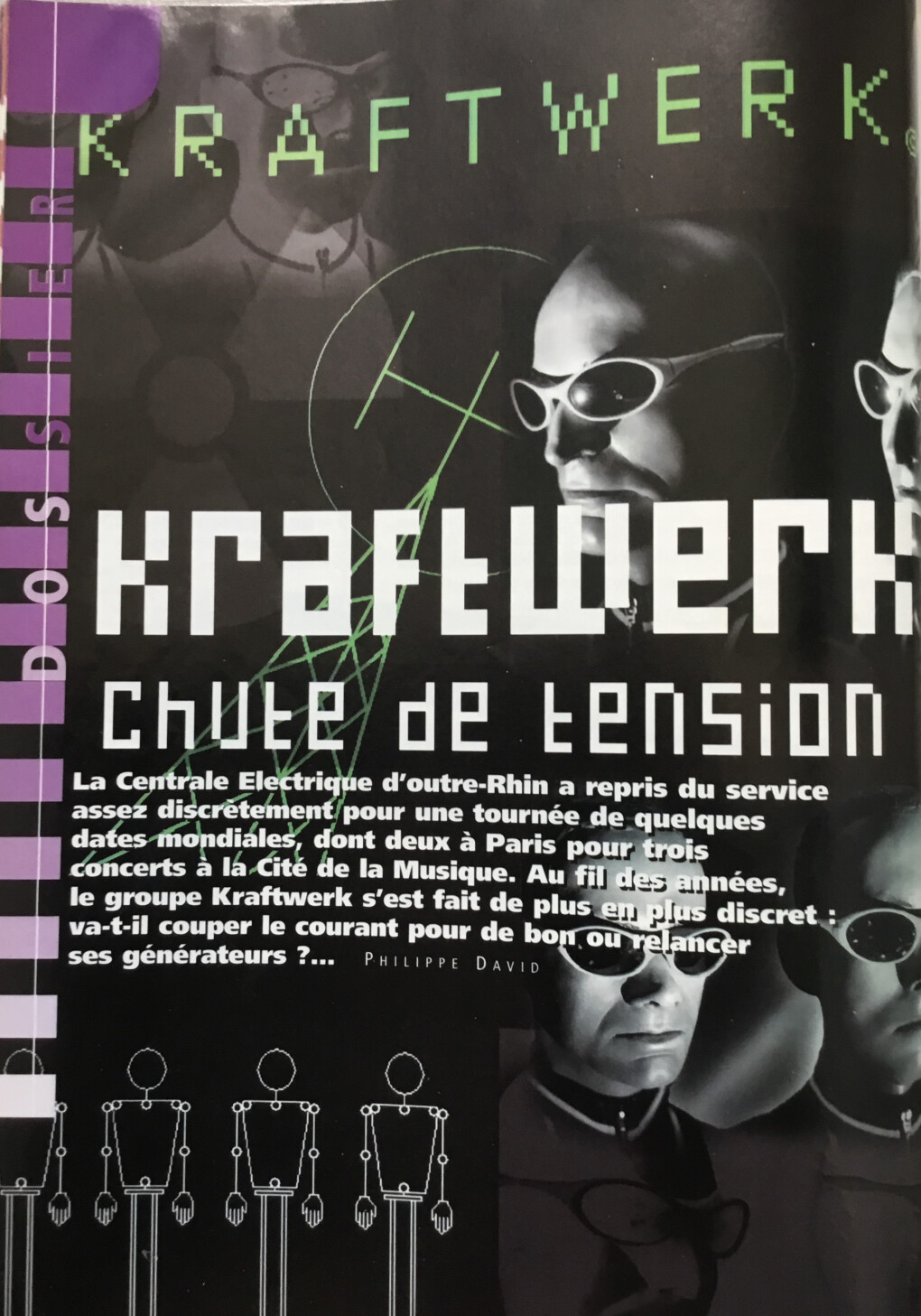
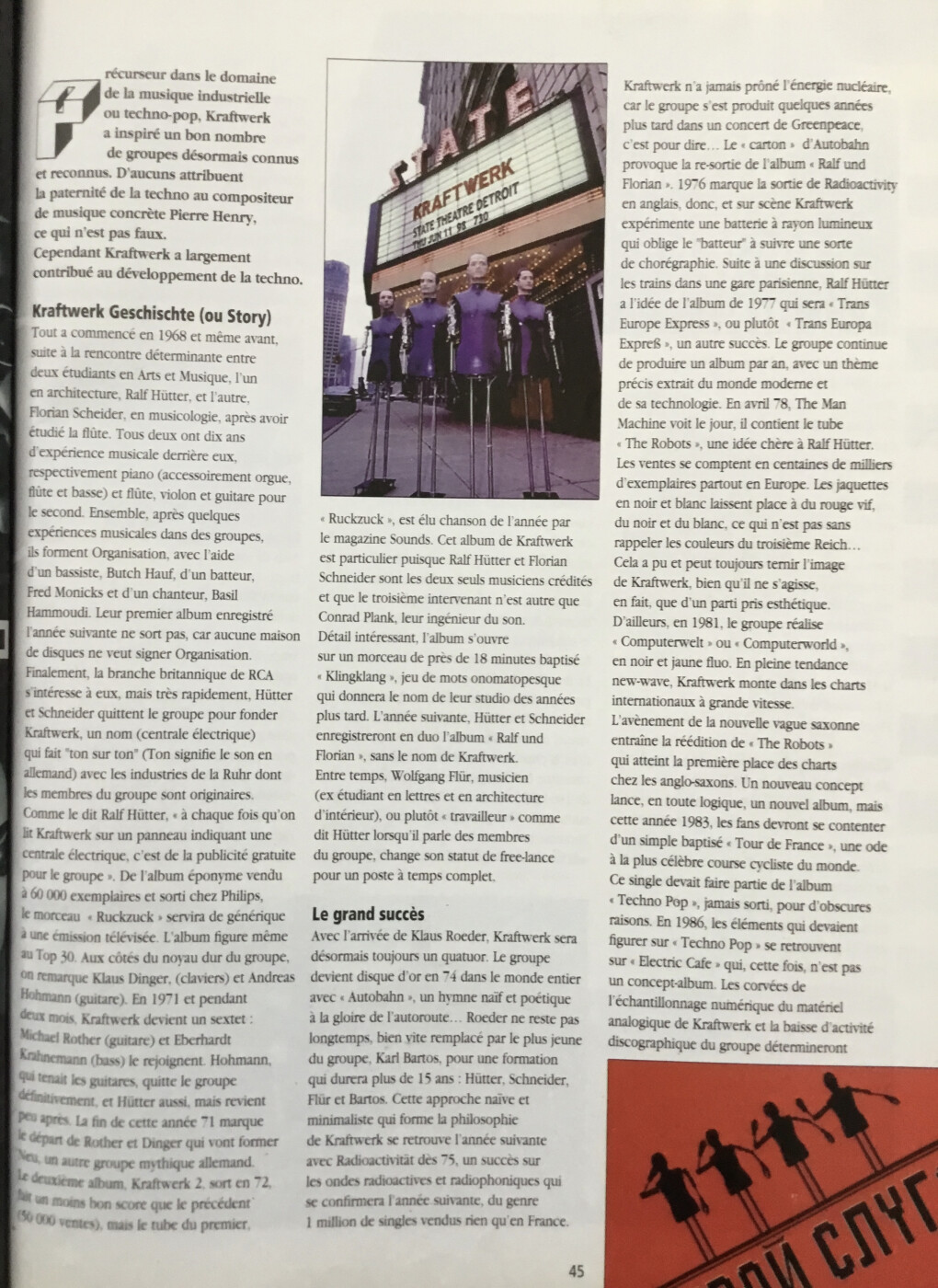
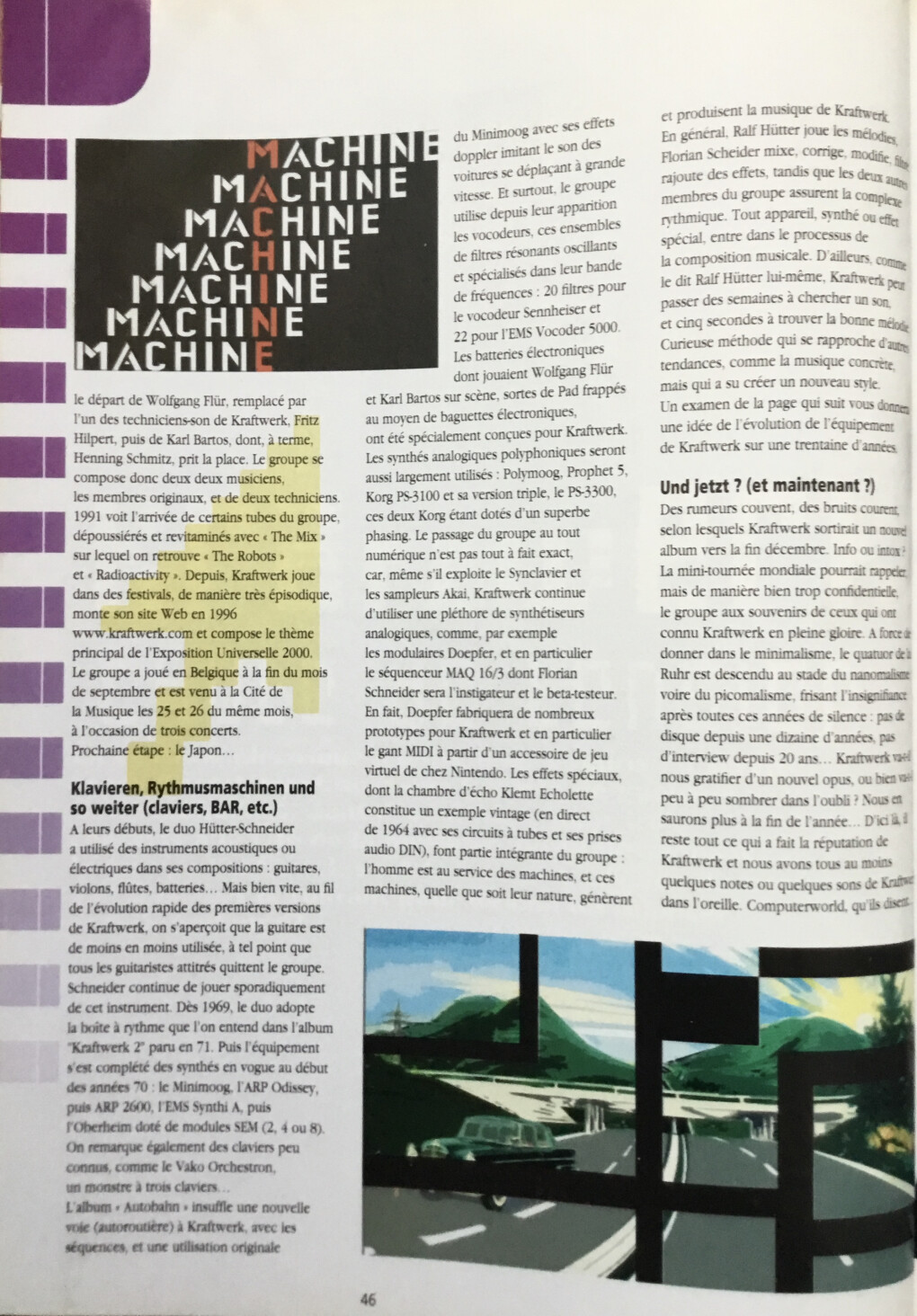
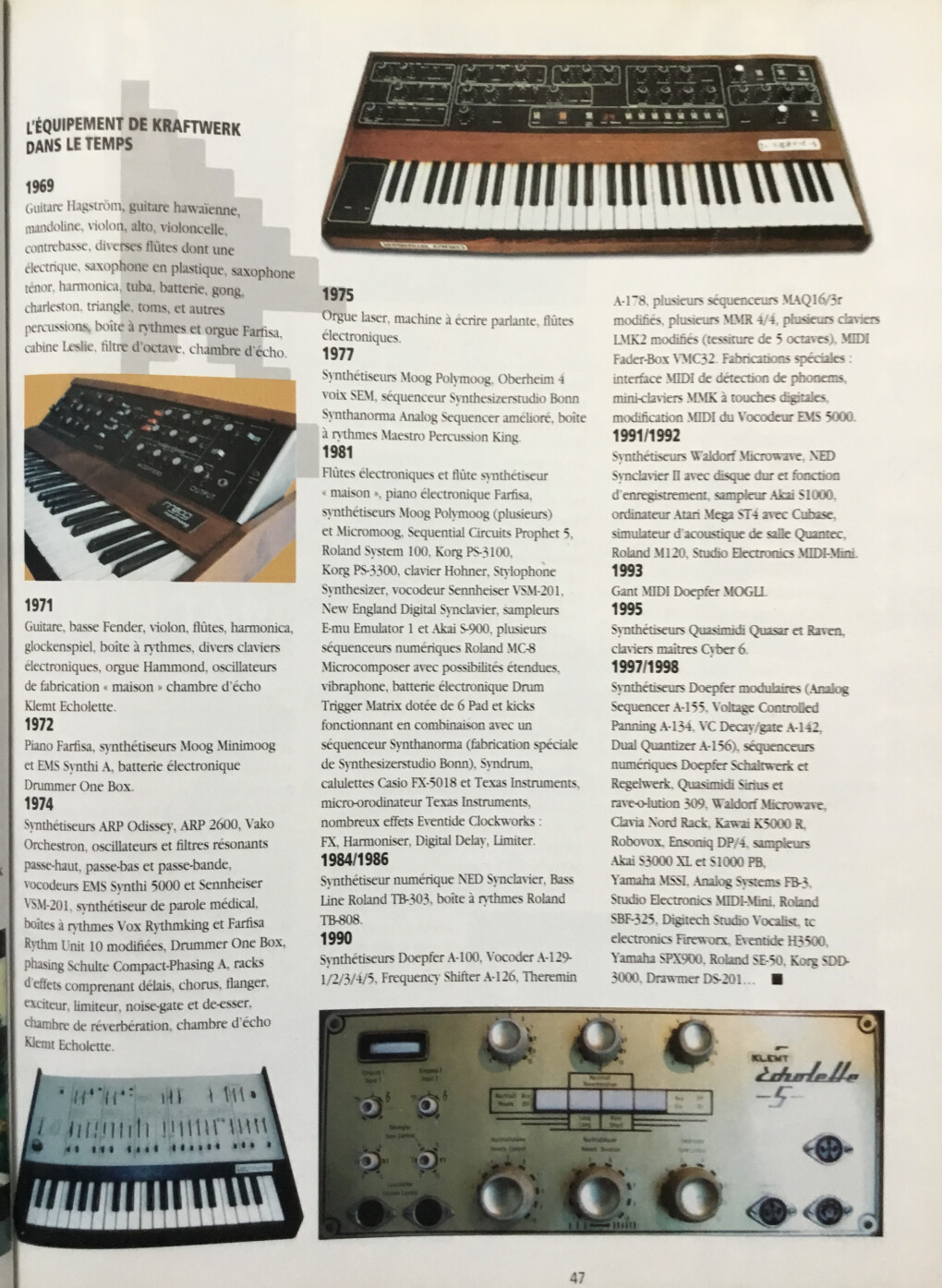
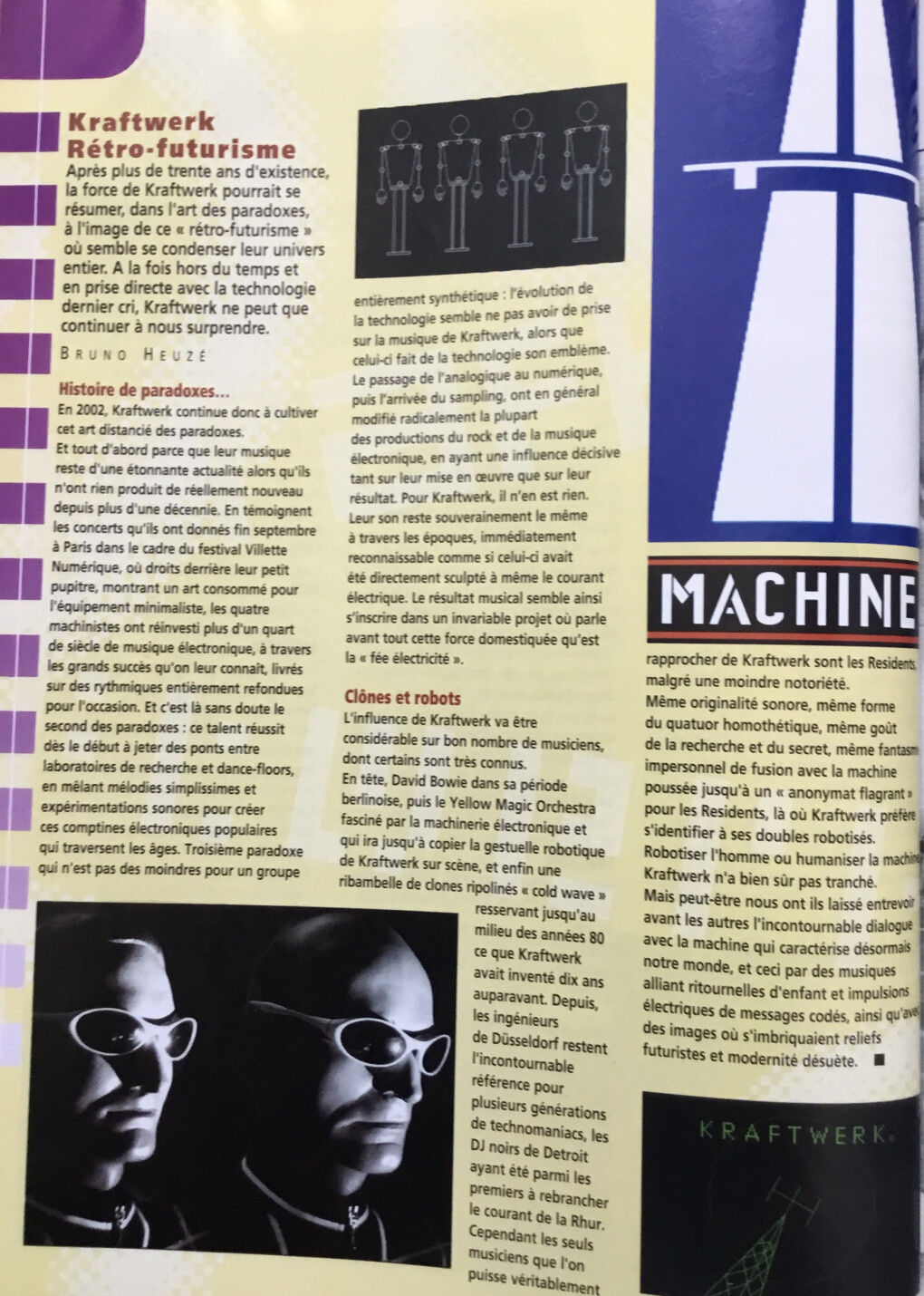
Ça vaut ce que ça vaut.





Présentez vous sur AudioFanzine
- < Liste des sujets
- Charte




